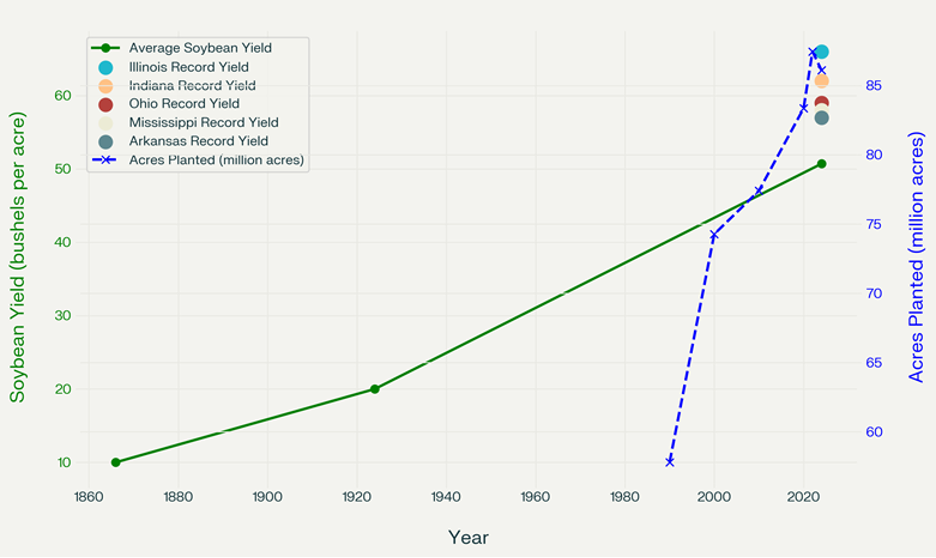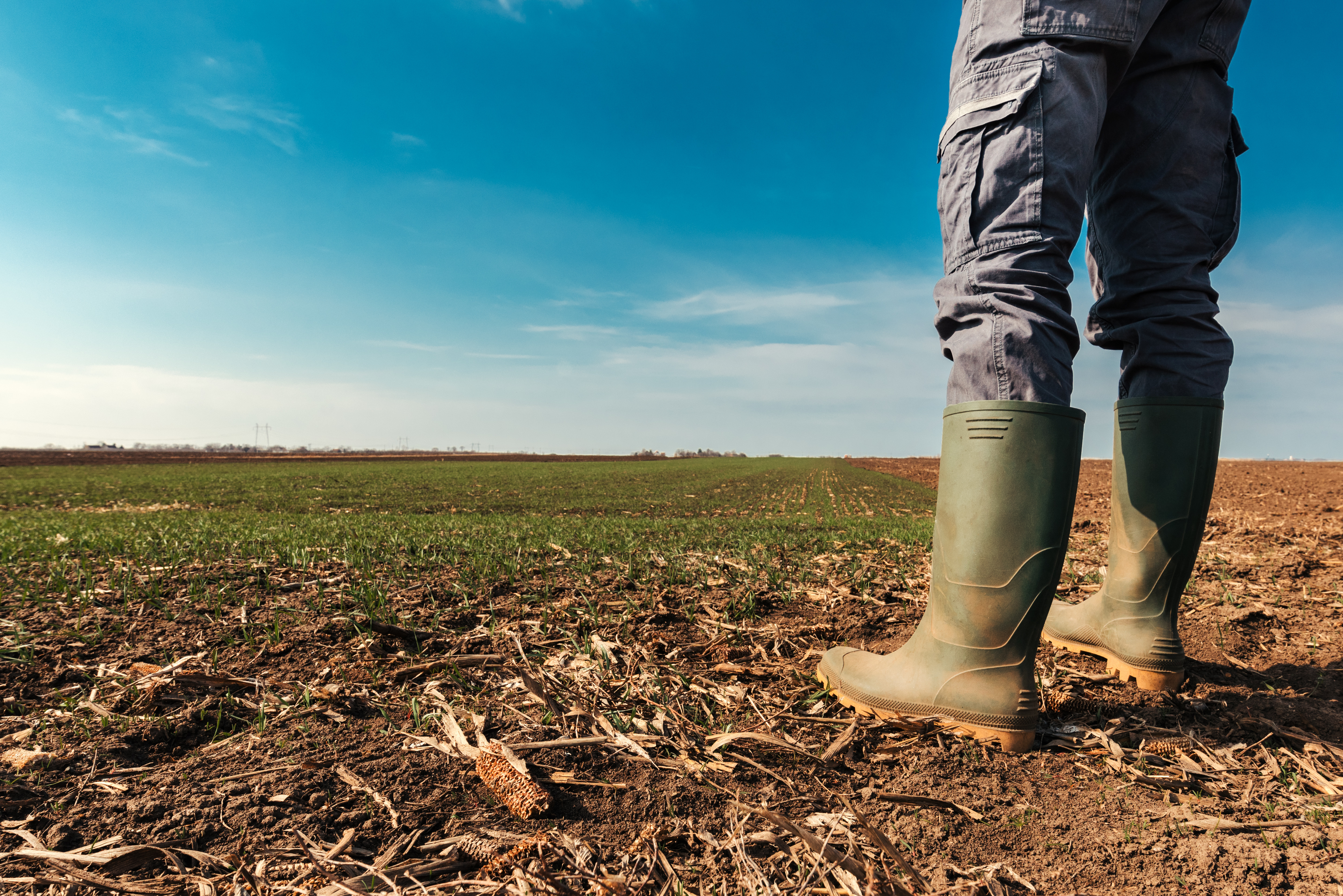By Katy Martin Rainey, PhD
In 2023, U.S. agricultural industries contributed roughly $1.537 trillion (5.5%) to GDP.1 Today, one U.S. farmer feeds 169 Americans,2 compared to just 15.5 in 19503—a testament to decades of agricultural innovation. Increased productivity over the past 75 years has brought both benefits and challenges for consumers and the environment. Overall, the trajectory of innovations in agriculture has trended toward greater safety and sustainability. Most recently, the attention has turned to regenerative agriculture. For many farmers, regenerative agriculture is not a fixed set of practices but a mindset of continuous improvement—an ongoing commitment to finding new ways to use resources more efficiently, enhance soil health, and maintain a profitable, resilient operation.
The Core of Regenerative Agriculture
Regenerative agriculture primarily aims to preserve, improve, and restore soil health by regenerating soils that have been degraded by past agricultural practices, resulting in soils that are healthier than their current state.4,5 Healthier soils also contribute to climate mitigation, improved water quality, increased soil organic matter, enhanced carbon sequestration, and increased biodiversity.4,5 Common regenerative practices include:
-
Cover cropping
-
Crop rotation
-
Promoting persistent living roots
-
Reduced or no-till farming
-
Agroforestry
-
Managed grazing
Advances in technology, equipment, and seed varieties are enabling farmers to adopt more sustainable practices that support both long-term land stewardship and their bottom line. While many regenerative methods have roots in pre-industrial farming traditions, it’s clear that scaling these practices for today’s farms will increasingly rely on modern innovations—helping farmers care for their land across generations while maintaining productive operations.
The Role of Modern Technology
Modern farming leverages a range of technologies—including genetic modification, precision equipment, and microbial inputs—to optimize outcomes for both productivity and sustainability. Among these tools, pesticides are often misunderstood due to a historical legacy that no longer reflects current practices.
The article "The Past, Present, and Future of Rangeland Grasshopper Management" by Kerri M. Skinner traces the evolution of grasshopper control in the U.S. rangelands from the 19th century to today.6 It provides a real-world example that underscores how today’s technology, when thoughtfully applied, allows farmers to reduce inputs, enhance efficiency, and support long-term sustainability goals. Initially driven by the devastation caused by the Rocky Mountain locust plague, also known as the Grasshopper Plague of 1874, early grasshopper population control methods included mechanical traps, crop rotation, and later chemical insecticides. Over time, the focus shifted from croplands to rangelands, where cost-effectiveness of treatment became a major concern. Growing environmental awareness led to research into biological controls like Nosema locustae, a microsporidium fungus bait, though with limited success. Today, management emphasizes ecological understanding, predictive modeling, and integrated strategies to sustainably control grasshopper populations while minimizing environmental impact.
Pesticides: A Vital and Carefully Regulated Tool in Modern Farming
Pesticides—including herbicides, insecticides, and fungicides—are essential tools that help farmers protect crops from weeds, insects, and diseases, ensuring a stable, safe, and abundant food supply. In regenerative farming systems, where soil health is prioritized, herbicides are often used to manage weeds and terminate cover crops in a way that avoids soil disruption. While practices like cover cropping offer benefits, they can also introduce challenges, such as creating habitats for pests that may later affect main crops. For example, researchers at North Carolina State University have documented how pests can move from dying cover crops to emerging soybean plants, increasing pressure on early-stage crops.7
Modern pesticides are designed with precision, targeting specific pests while minimizing unintended effects on humans and the environment. Extensive safety testing is required before any pesticide is approved for use, including evaluations for potential carcinogenicity, reproductive harm, and environmental impact. Synthetic pesticide residues found in food are present at extremely low levels—far below the thresholds considered safe by regulatory agencies. These limits are set through rigorous scientific assessments by agencies like the U.S. Environmental Protection Agency, which reviews toxicological data and sets conservative safety margins to protect even the most vulnerable populations.
When used responsibly as part of an integrated farm management plan, pesticides support crop health and contribute to more sustainable practices. With strong regulatory oversight and ongoing innovation, farmers can use these tools safely and effectively to meet growing food demands.
The Future: Innovation Driving Regeneration
The path to sustainable agriculture will depend on:
-
Continued investment in research and technology.
-
Embracing diverse tools from advanced crop genetics and precision technologies to responsible pesticide use.
-
Supporting soil health and climate resilience through regenerative principles.
Recent trends in U.S. soybean production illustrate this dynamic. National yields have risen from about 43 to over 50 bushels per acre since 2002, even as soybean acreage has expanded into marginal lands and new regions (Figure 1). The expansion into less traditional growing areas demonstrates that, with the right combination of technology and stewardship, yield improvements are possible even under more challenging conditions.
Regenerative agriculture isn't a return to the past—it's a forward-looking fusion of tradition and innovation. With the right combination of ecological insight, cutting-edge science, and strategic inputs, U.S. farmers can continue to grow more while doing better—for the land, the economy, and future generations.

Figure 1: Historic average U.S. soybean yields, soybean acres area planted since 1988, and 2024 record soybean yields.8-10
REFERENCES
-
Zahniser, S. and Kassel, K. 2024. What is agriculture's share of the overall U.S. economy? www.ers.usda.gov/data-products/.
-
American Farm Bureau Federation's "Fast Facts" page: https://www.fb.org/newsroom/fast-facts.
-
Growing A Nation – Prosperity and Challenges 1950–1969: https://growinganation.org/content/show-content/prosperity_and_challenges/.
-
What is regenerative agriculture?: https://www.weforum.org/stories/2022/10/what-is-regenerative-agriculture/.
-
What is regenerative agriculture?: https://www.noble.org/regenerative-agriculture/.
-
Sayre, N. F. (2001). The new ranch handbook: A guide to restoring western rangelands. Rangelands, 23(3), 39–41. “The Past, Present, and Future of Rangeland Grasshopper Management.” Retrieved from https://journals.uair.arizona.edu/index.php/rangelands/article/viewFile/11457/10730.
-
Think About Pests When Terminating Cover Crops Prior to Planting Soybeans. https://soybeans.ces.ncsu.edu/2021/03/pfp21-think-about-pests-when-terminating-cover-crops-prior-to-planting-soybeans/.
-
Crop Production 2024 Summary. https://downloads.usda.library.cornell.edu/usda-esmis/files/k3569432s/nk324887m/qn59s0097/cropan25.pdf.
-
USDA Report Projects Record 2024 Corn and Soybean Yields. https://www.morningagclips.com/usda-report-projects-record-2024-corn-and-soybean-yields/.
